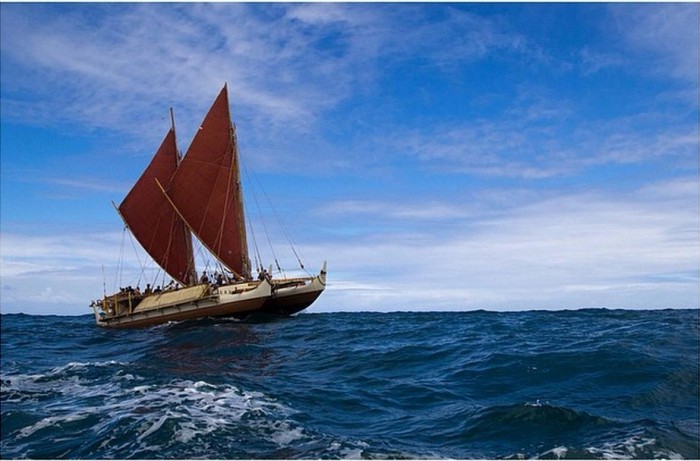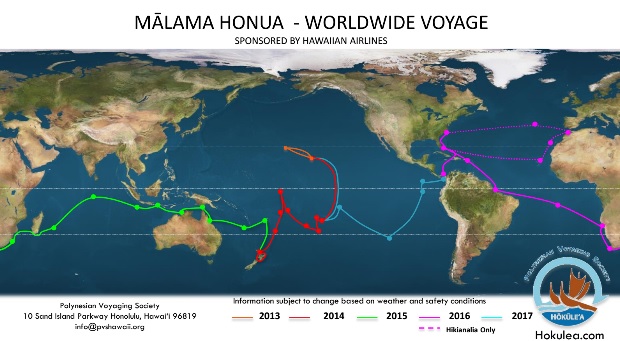
Photo credit: Polynesian Voyaging Society
If there remains any question about the sophistication or modern-day capacity of traditional navigation, the Polynesian Voyaging Society’s ambitious three-year worldwide voyage will certainly put those questions to rest.
The voyage, which began earlier this year with sails across Hawai‘i, left last week for Tahiti.
It realizes a multicultural, multigenerational vision of cultural leaders who long advocated for greater recognition for the value of traditional ecological knowledge. Among them was Master Navigator Mau Piailug, the Satawal native who became instrumental in training navigators in Hawai‘i starting in the 1970s. He was one of the first navigators of the Hōkūle‘a, the double hulled traditional sailing canoe built by the Polynesian Voyaging Society to foster the revival of traditional navigation in the Pacific.
Photo of Mau carving canoe plank in native Satawal. (Photo credit: University of Hawai‘i, Traditional Micronesian Navigation Collection)
Mau’s willingness to work with Hawaiians and become a teacher in the early years of the Polynesian Voyaging Society—a nonprofit organization founded in Hawai‘i—not only shaped the Society itself, but set into the foundation of the organization and its programs a deep appreciation for cross-cultural teamwork.
Master Navigator Nainoa Thompson, who was a student of Mau’s, once said of the Hōkūle‘a historic 1976 traditional voyage from Hawai‘i to Tahiti, “The success of Mau’s navigation sparked pride in the Hawaiian and Polynesian culture and a renaissance of voyaging, canoe building, and non-instrument navigation that has continued to grow, spreading across Polynesia and reaching to its far corners of Aotearoa and Rapanui and creating a family of Pacific voyagers.”
Over the last forty years, the program and family of voyagers has grown significantly.
The current worldwide voyage, entitled Mālama Honua (care for the earth in Hawaiian), looks to bring global awareness to the critical status of our ocean environments. According to the organization, the voyage will be “covering 47,000 nautical miles, 85 ports, and 26 countries, the Mālama Honua Worldwide Voyage will highlight diverse cultural and natural treasures and the importance of working together to protect them.”
Multigenerational crews have been training for years to be part of this historic effort.
Photo shows the anticipated route of the Worldwide Voyage. (Photo credit: Polynesian Voyaging Society)
To increase capacity for the sail, the Society acquired a second sailing vessel to accompany the Hōkūle‘a on the journey. The second canoe, Hikianalia, is a “modern Polynesian voyaging canoe,” and an innovative combination of both western and traditional science. As explained by the Society, “Hikianalia uses sustainable solar and wind energy and combines the latest ecological technology with the heritage of the voyaging tradition. She is equipped with the communications technology that will allow us to connect to a global audience, and combines contemporary and traditional indigenous knowledge to bring the world with us on this journey.”
This voyage (the first of it’s kind) is a global effort that combines the very best in traditional knowledge from local communities and the very best of modern technology and conservation practices.
Groups from around the world have stepped forward to support the effort. It is an important message for all conservation groups and local communities to hear: our potential is immeasurable if we work together.
The purpose of the voyage is for it’s participants to engage in a variety of activities aimed at highlighting the impacts of climate change, marine pollution and other critical issues.
Activities include the crew taking the voyage into marine protected areas as a means to raise awareness for their protection. Modern technology has also allowed for regular communication from the ship, which is being shared via satellite and through social media. One of the voyage’s core missions is to engage a community of global learners, and as such the Society and voyage has developed tools and context to teach children and communities about conservation and ocean health.
The greatest hope of this extraordinary effort is that through this historic voyage, which honors the collective knowledge of past, a global community will be motivated to commit to a cooperative path towards a inspired and sustainable future.
Photo credit: Polynesian Voyaging Society
Love elephant and want to go steady?
Sign up for our (curated) daily and weekly newsletters!
Editor: Renée Picard
Images: courtesy of the author









Read 1 comment and reply